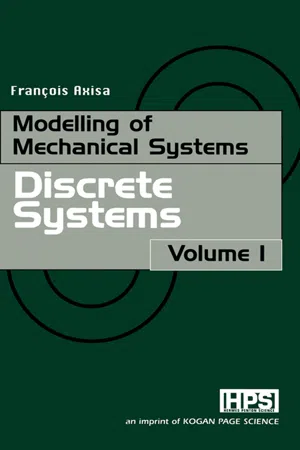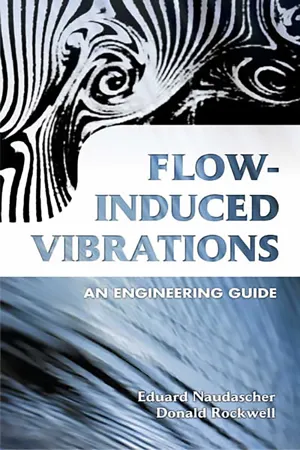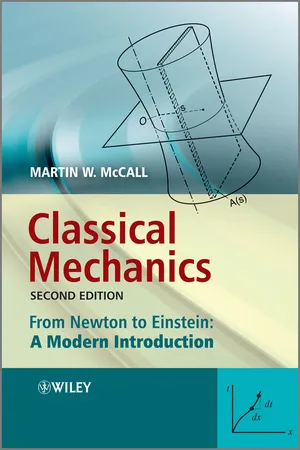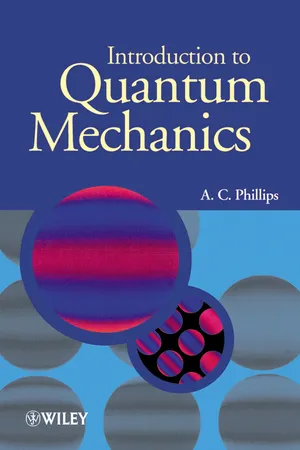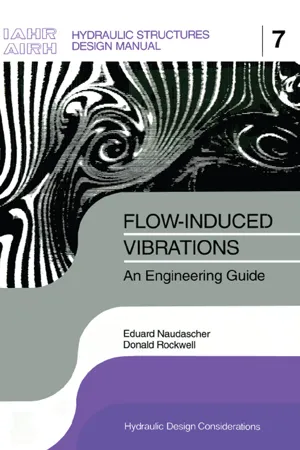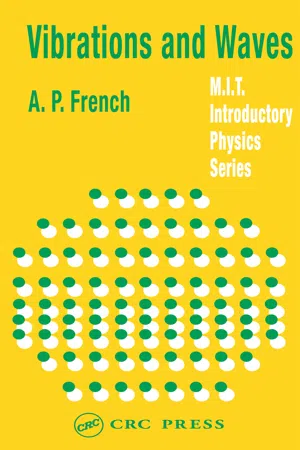Physics
Spring-Block Oscillator
A spring-block oscillator is a system consisting of a mass attached to a spring, which oscillates back and forth. The mass experiences a restoring force from the spring, causing it to oscillate with a specific frequency determined by the mass and the spring constant. This system is often used to study simple harmonic motion and oscillatory behavior in physics.
Written by Perlego with AI-assistance
Related key terms
Related key terms
1 of 4
Related key terms
1 of 3
8 Key excerpts on "Spring-Block Oscillator"
- Francois Axisa(Author)
- 2003(Publication Date)
- Butterworth-Heinemann(Publisher)
natural modes of vibration, which will be further extended in the next chapter to the case of MDOF systems. Furthermore, because of their relative simplicity, SDOF systems give us a good opportunity to make a first incursion into the nonlinear domain of dynamics. Indeed, even a limited study is enough to illustrate significant differences between the dynamical behaviour of linear and nonlinear systems.5.1 Linear oscillators
5.1.1 Mechanical oscillatorsA mechanical system is said to vibrate, or oscillate, when it is swinging back and forth about a permanent state of equilibrium, static or not. This state, which will be used as a reference to describe the vibration, is assumed to be stable. Indeed, vibration occurs as the result of the conflicting action of the inertial forces, which cause the resulting motion to overshoot the permanent state of equilibrium, and that of the restoring stiffness forces, which are tending to bring it back. Mechanical oscillators are the simplest systems of this kind. They correspond to devices which can be reduced to a mass-point and a spring. The back and forth motion takes place along a geometrical line which is prescribed a priori. Hence, according to the definition given in Chapter 1 , a mechanical oscillator is a SDOF system. Clearly, such a concept arises as a mathematical idealization of a few real, but particularly simple, devices. Two archetypes, already introduced in the preceding chapters, are the mass-spring system and the simple pendulum. The basic difference between them is in the nature of the potential energy, and thus of the stiffness force, involved in the system. In masspring-like systems, restoring forces are induced by the elastic deformation of a body, while in pendulum-like systems, restoring forces arise as the consequence of a coupling between the motion and a permanent force field, the weight for instance. More generally, the permanent force field is said to prestress the system and the pendulum may be considered as a prestressed, or initially stressed oscillator.- eBook - ePub
Flow-Induced Vibrations
An Engineering Guide
- Eduard Naudascher, Donald Rockwell(Authors)
- 2012(Publication Date)
- Dover Publications(Publisher)
CHAPTER 2Body oscillators
2.1 OVERVIEW AND DEFINITIONS
Because the writers’ main goal is to identify the variety of mechanisms by which flow-induced vibrations are excited, the structural dynamics are presented in the simplest way possible throughout this monograph. In most cases, this means representing the vibrating structure or structural part as a discrete mass, free to oscillate with one degree of freedom, linearly damped, and supported by a linear spring (Figures 2.1 and 2.2 ). The following sections contain a brief review from the field of mechanical vibrations concerning these simple body oscillators that is sufficient for the understanding of the monograph. A method of generalization is presented, finally, by which simple-oscillator concepts become applicable to more complex systems with continuous or distributed masses such as beams, plates, and shells.Any vibration is describable in terms of sinusoidal functions. The simplest vibration is a harmonic motion of the form(2.1)where x = body deflection from its time-mean position, x o = amplitude, t = time, ω = circular frequency, and ƒ = frequency in cycles per second or Hertz. One of the most useful ways of describing simple harmonic motion is obtained by regarding it as the projection on the horizontal axis of a vector of length x o rotating counterclockwise with uniform angular velocity ω (Figure 2.1 ). This rotating-vector description is commonly represented by the complex exponential function(2.2)for which O x is the ‘real’ and O y is the ‘imaginary’ axis (i ≡ ). Thus, the real part of this expression may be considered the horizontal projection and the imaginary part the vertical projection; and again, it is the former which represents the harmonic motion or vibration. In Figure 2.1b, T = 1/ƒ denotes the period of vibration.Figure 2.1 - Tamer Bécherrawy(Author)
- 2013(Publication Date)
- Wiley-ISTE(Publisher)
Chapter 3 Forced OscillationsOscillations are said to be forced if the oscillator is permanently subject to external forces as well as internal restoring forces and friction forces. In this chapter we assume that the oscillator is linear ; this is the case for mechanical systems subject to ordinary forces and electric circuits formed by ideal resistors, inductors and capacitors and connected to generators. Then, the superposition principle is valid: if several forces act simultaneously on a linear system, the resulting motion is the superposition of the motions produced by each force acting separately.In this chapter we study the forced oscillations of a system with one or several degrees of freedom especially in the case of a simple harmonic excitation force. The response of the system is particularly important if the excitation frequency is close to the natural frequency or one of the normal frequencies of the system; this phenomenon is called resonance . This study is important because several systems may be modeled as harmonic oscillators, and because the Fourier theory allows us to consider any excitation force as a superposition of harmonic forces.3.1. Transient regime and steady regime
The equation of an oscillator with one degree of freedom, which is subject to an external force F (t ), is where µ is its inertial parameter, −Ku is the restoring force and is the dissipative force. We may also write[3.1 ]F (t ) is a generalized force , that is, any cause that may produce or modify the motion or change the state of a system by supplying or extracting energy. If u is the x -coordinate of a particle, the generalized force is the x -component F x of the ordinary force acting on the particle. If u is the rotation angle about an axis Oz , the generalized force is the z- component of the moment of the forces about O and if u is the charge of a capacitor, the generalized force is the e.m.f.- eBook - ePub
Classical Mechanics
From Newton to Einstein: A Modern Introduction
- Martin W. McCall(Author)
- 2011(Publication Date)
- Wiley(Publisher)
models , exemplars of many oscillatory systems in physics. The analogue is exact for many electrical circuits wherein the ideas discussed find wide application. Even when the analogue is not perfect the results can still be effective – electrons in atoms are not really connected to the nuclei by springs, but a classical oscillator model provides a fair description.3.2 Prototype Harmonic OscillatorWe begin with what is essentially the problem analysed in Section 2.10 of the previous chapter. Consider the prototype oscillator model shown in Figure 3.1 . The mass, resting on a frictionless surface, is connected to a rigid support via a spring. When drawn to the right the distance from its equilibrium position is identified as x . Since it is not too far from equilibrium, the elastic limit is not exceeded and therefore the restoring force acting to the left is given by (−kx ), where k is the spring constant (units N m−1 = kg s−2 ). Applying Newton’s second law, the equation of motion ism+ kx =0 or, dividing through by the mass and defining ω 0 2 ≡ k/m,(3.1)Figure 3.1prototype mass−spring harmonic oscillator.Note that the parameter ω 0 has been introduced to emphasise that the motion depends on just one number, and since k/m is definitely positive we make it the square of this parameter. The physical significance of ω 0 will be clear once we have solved the equation of motion, Equation (3.1 ). Equation (3.1 ) is the equation of Simple Harmonic Motion (SHM), but in order to solve it rigorously, we need to know some facts about differential equations.3.3 Differential Equations The sorts of differential equations (DE’s) we are considering are of the form(3.2)where there is only one dependent variable (space) and only one independent variable (time). For coupled oscillators we will relax the condition of only one dependent variable, but the results quoted below will still hold. The fact that there is only one independent variable means that we are dealing with ordinary (as opposed to partial) differential equations. We further assume that the coefficients (a,b,c )are independent of time, although d is either zero or time-dependent.1 - eBook - ePub
- A. C. Phillips(Author)
- 2013(Publication Date)
- Wiley(Publisher)
This chapter deals with the quantum mechanical behaviour of a particle in a harmonic oscillator potential. We shall find the energy eigenvalues and eigen-functions, and explore the properties of stationary and non-stationary quantum states. These states are very important in molecular and solid state physics, nuclear physics and, more generally, in quantum field theory.6.1 THE CLASSICAL OSCILLATOR
The simplest example of a harmonic oscillator is a particle on a spring with elastic constant k . When the particle is displaced from equilibrium by a distance x , there is a force F = –kx which opposes the displacement. Because the work needed to move the particle from x to x + dx is kx dx , the potential energy stored by displacing the particle by a finite distance x is(6.1)This potential energy is converted into kinetic energy when the particle is released.The equation of motion for a particle of mass m is(6.2)and this is usually rewritten as(6.3)where is the acceleration of the particle and The general solution is(6.4)where A and α are two constants which may be determined by specifying the initial position and velocity of the particle; for example, if the particle is released from rest at position x 0 , then A =x0and α = 0.Eq. (6.4) describes simple harmonic motion with amplitude A , phase α and angular frequency ω or period 2π/ω . During the motion, the potential energy rises and falls as the kinetic energy falls and rises. But the total energy E , the sum of the kinetic and potential energies, remains constant and equal to(6.5)In the real world of quantum mechanics, simple harmonic motion with definite energy, frequency, phase and amplitude never really happens. We shall see that oscillators either have definite energy and do not oscillate, or they oscillate with uncertain energy. However, we shall see that, in special circumstances, the oscillations are almost like simple harmonic motion.6.2 THE QUANTUM OSCILLATOR
The definingproperty of a quantum system is its Hamiltonian operator. For a one-dimensional harmonic oscillator the Hamiltonian operator isor, if we use Eq. (3.30) - eBook - ePub
Flow-induced Vibrations: an Engineering Guide
IAHR Hydraulic Structures Design Manuals 7
- Eduard Naudascher(Author)
- 2017(Publication Date)
- Routledge(Publisher)
CHAPTER 2 Body oscillators 2.1 OVERVIEW AND DEFINITIONSBecause the writers’ main goal is to identify the variety of mechanisms by which flow-induced vibrations are excited, the structural dynamics are presented in the simplest way possible throughout this monograph. In most cases, this means representing the vibrating structure or structural part as a discrete mass, free to oscillate with one degree of freedom, linearly damped, and supported by a linear spring (Figures 2.1 and 2.2 ). The following sections contain a brief review from the field of mechanical vibrations concerning these simple body oscillators that is sufficient for the understanding of the monograph. A method of generalization is presented, finally, by which simple-oscillator concepts become applicable to more complex systems with continuous or distributed masses such as beams, plates, and shells.Any vibration is describable in terms of sinusoidal functions. The simplest vibration is a harmonic motion of the formx =x ocos ω t , ω = 2 π f(2.1) where x = body deflection from its time-mean position, xo= amplitude, t = time, ω = circular frequency, and f = frequency in cycles per second or Hertz. One of the most useful ways of describing simple harmonic motion is obtained by regarding it as the projection on the horizontal axis of a vector of length xorotating counterclockwise with uniform angular velocity ω (Figure 2.1 ). This rotating-vector description is commonly represented by the complex exponential functionx ( t ) =x oe=i ω tx o( cos ω t + i sin ω t )(2.2) for which Ox is the ‘real’ and Oy is the ‘imaginary’ axisFigure 2.1. Definition sketch, (a) Simple undamped body oscillator, (b) Histogram of harmonic motion, (c) Vector respresenlation of harmonic motion.(. Thus, the real part of this expression may be considered the horizontal projection and the imaginary part the vertical projection; and again, it is the former which represents the harmonic motion or vibration. In Figure 2. lb , T = 1/f denotes the period of vibration.i ≡)− 1 - eBook - ePub
- A.P. French(Author)
- 2017(Publication Date)
- CRC Press(Publisher)
3The free vibrations of physical systemsIN MAKING THE STATEMENT quoted opposite about the elastic properties of objects, Robert Hooke rather overstated the case. The restoring forces in any actual physical system are only approximately linear functions of displacement, as we noted near the beginning of Chapter 1 . Nevertheless, it is remarkable that a vast variety of deformations of physical systems, involving stretching, compressing, bending, or twisting (or combinations of all of these) result in restoring forces proportional to displacement and hence lead to simple harmonic vibration (or a superposition of harmonic vibrations). In this chapter we shall consider a number of examples of such motions, with particular emphasis on the way in which we can relate the kinematic features of the motion to properties that can often be found by purely static measurement. We shall begin with a closer look at the system that forms a prototype for so many oscillatory problems—a mass undergoing one-dimensional oscillations under the type of restoring force postulated by Hooke. Much of the discussion in the next section will probably be familiar ground, but it is important to be quite certain of it before proceeding further.The Basic Mass-Spring Problem
In our first reference to this type of system in Chapter 1 , we characterized it as consisting of a single object of mass m acted on by a spring [Fig. 3-1 (a) ] or some equivalent device, e.g., a thin wire [Fig. 3-1(b) ], that supplies a restoring force equal to some constant k times the displacement from equilibrium. This identifies, in terms of a system of a particularly simple kind, the two features that are essential to the establishment of oscillatory motions:Fig. 3-1 (a ) Mass-spring system . (b ) Mass-wire system - eBook - ePub
Ultrasonics
Fundamentals, Technologies, and Applications
- Dale Ensminger, Leonard J. Bond(Authors)
- 2024(Publication Date)
- CRC Press(Publisher)
An acoustic wave can exist in a medium only because the medium has mass and elastic properties. Sound cannot travel through a vacuum. The incremental mass affected by an ultrasonic wave and its elastic couplings are analogous to an oscillating mass attached to springs. Therefore, prior to developing the various wave equations, simple mass-spring oscillators are considered.3.2.1 Ideal Condition – Simple Harmonic Motion (SHM)
The simplest vibration in many mechanical and electrical systems can be described using the relationships which describe the action of a mass attached to two springs, as illustrated in Figure 3.1 . For simplicity, the system shown in Figure 3.1 is assumed to be ideal; that is, no friction or other losses and hence no energy is dissipated when the mass is set in motion. In actual practice, the ideal conditions can only be approximated, and the equations derived in this section can be applied to engineering designs in which energy losses are very small. Where these losses are significant the equations for damped motion developed in Section 3.2.2 apply.Figure 3.1Simple spring-mass oscillator.To fulfill the hypothetical conditions, it must be assumed that the mass rests on a frictionless surface. Since the surface is horizontal, the gravitational pull on the mass is constant, regardless of the position of the mass. In addition, assume that the system is located in a vacuum so that when the mass moves there is no loss of energy due to air resistance. Under such conditions, when the mass is displaced to the right by a distance x, the spring to the left is subjected to tension and the spring on the right to compression, with the resulting forces tending to restore the mass to its original position. If the total force exerted by the springs on mass M (in kg) is Fx (in N) and the combined spring constant (defined as the force required to displace the springs over unit distance) is k, the magnitude of the total force Fs exerted on the mass M isF = - k x(3.1)where x is the distance in meter that the mass is displaced from the rest position. The negative sign is used because the force is in a direction opposite to the displacement x. If the mass M is released, the forceF s
Index pages curate the most relevant extracts from our library of academic textbooks. They’ve been created using an in-house natural language model (NLM), each adding context and meaning to key research topics.
Explore more topic indexes
Explore more topic indexes
1 of 6
Explore more topic indexes
1 of 4
